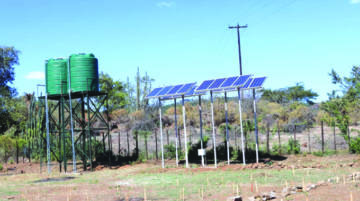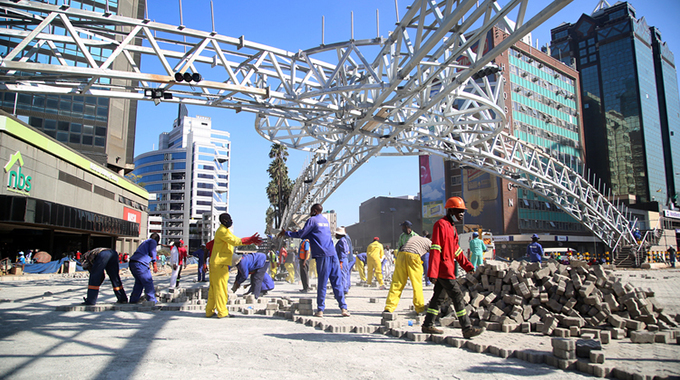New dam revives hopes of Mwenezi villagers

Completion of Rata Star Dam at Masvasvuke village in Mwenezi district has brought relief to smallholder farmers who have lost livestock due to frequent droughts that often ravage this drought prone part of the country.
Before construction of the dam, smallholder farmers lost 7 000 cattle in the 2015/2016 drought, the worst in nearly four decades.
Reports abound that some farmers lost as much as 30 or 40 cattle each, bringing untold hardships and misery.
“During the 2015/2016 drought, the situation was bad,” said Veronica Muchechetere, an Agritex officer in Mwenezi. “One farmer in Ward 16 of Mwenezi died from stress after losing 48 cattle.
“It was quite painful for him and most other farmers. They watched helplessly as cattle died in their numbers.”
But the construction of Rata Star Dam, with support of a US$100 million project implemented by CARE, ICRISAT and PLAN with funding from the European Union, the embassy of Sweden, the United Nations Development Programme (UNDP) and the Foreign, Commonwealth and Development Office (FCDO), formerly known as DFID, has helped to reduce livestock deaths.
Farmers are now benefiting immensely with the intervention of the Zimbabwe Resilience Building Fund (ZRBF) Enhancing Community Resilience and Sustainability (ECRAS) project.
ECRAS was funded for US$9,7 million out of the ZRBF US$100 million budget. It will run until 2022 and aims to contribute to an increased capacity of communities to protect development gains in the face of recurrent shocks and stresses enabling them to contribute to the economic development of Zimbabwe.
“Ever since ECRAS intervened and constructed a small dam, livestock deaths have fallen drastically to 564 for the whole district as of December 2020,” said Muchechetere.
“Water is the most important nutrient for animals and farmers here are happy that this dam is now essential to ensure their animals have ample access to water.”
Muchechetere said having water available to livestock allows for optimal animal performance and health as well as better livestock productivity.
In 2019, farmers lost over 30 000 cattle to a combination of drought that decimated pastures and drinking water and various diseases such as anthrax, January Disease (Theileriosis) and tick-borne diseases, due to lack of dipping chemicals.

Farmers have now established a nutrition garden powered by a solar water pump near Rata Star Dam
Farmers in Mwenezi — in the southern part of Zimbabwe are often affected by back to back droughts as climate change takes hold.
Livestock is a major source of livelihood for villagers and the death of cattle often leaves them without the much-needed draught power, exposing them to food insecurity due to tillage challenges.
Water availability, livestock feed making and better livestock practices to better cope with dry times are vital for them to cope with droughts and other natural shocks.
“This ECRAS project has helped us a lot. I have 21 cattle and ever since this dam was built I have not lost any cattle,” said Taurai Mazaranye of Masvasvuke village.
“We got training on fodder making and animal disease management from this project. Cattle deaths have fallen and we are happy about it. This is our bank and saving them from deaths means we have more wealth for ourselves.”
Added Siyaphela Hlongwane, another farmer at Tengera village: “The dam is quite useful for us. Our area is dry and in the past our cattle could move distances of up to 10km to drink water.
“Lack of water led to reduced weight gains, milk production and animal performance. But now things have changed. We have enough water from Rata Star Dam. I feel relieved and I am now confident that our livestock will not die from droughts.”
Livestock deaths have serious implications on wealth building, income and farmer savings.
Whenever there is a drought, cattle die in part because cash-strapped farmers can’t afford to buy the supplementary feed their animals need. But with a nutrition garden near the dam, as well as fodder gardens, farmers are optimistic that the losses from future droughts will not be severe.
“We are now in the process of baling our fodder, harvesting our velvet beans and crops to build our livestock feed for use in the dry season,” said Johannes Mupisa, a poet and farmer.
“Water access is a game changer. This dam will improve our lot and save our livestock. Cattle is our main bank and we welcome any strategy that will save our wealth.”
And, farmers here in the livestock-rich Mwenezi district are certain that if another drought occurs, no animals will die from thirst and lack of food.
“I have 19 cattle and with better water availability at Rata Star Dam, I want to grow my herd to 50,” said Hlongwane. “The cattle are my pension. It’s also my medical aid and income for my survival.”









Comments